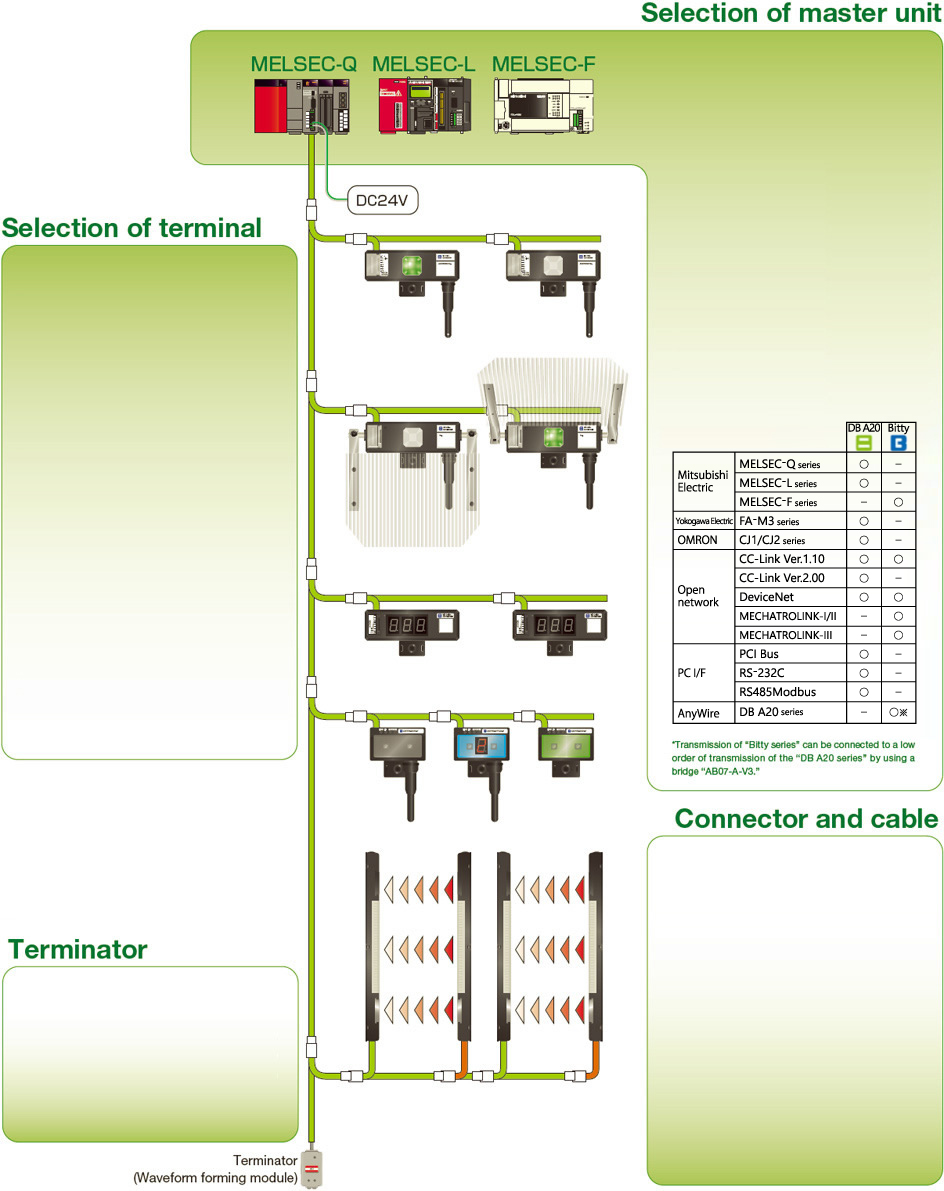
Configuration of POKAYOKE system
Con guration of the POKAYOKE system requires a “Master unit” and “Terminator” in addition to the POKAYOKE terminal, and an “electric wire” and “connector” connecting them, and “24V DC stabilized power source.”

- Select the master unit to be used for your POKAYOKE system according to the sequencer and open network to be (schedule) used.
When the master unit has been determined, transmission protocol which you can use is also determined, then select the POKAYOKE terminal that corresponds to the protocol.
Although two types of transmission protocol are not compatible with each other, the transmission line of the Bitty series can be connected to the lower position of the transmission line of the DB A20 series via a bridge. -
Narrow down the POKAYOKE terminals you want to use with reference to features of individual products such as “ indication, instruction,” “response, detection” and “how to install , ”and site environment and purpose for introduction.
It is also necessary to pay attention to the “transmission protocol” and “address setting method” at that time.- *Products of different protocols cannot be combined for use.
- *Even if products of different address setting methods are combined, operation can be performed. However, mistakes may result at the time of setting work, therefore, it is not recommended.
Suffi ciently confi rm the specifi cations referring to the catalog and Product Guide (Product instruction manual) to determine the con guration. - Al l POKAYOKE terminals are shipped with a link connector (LP connector) connected.
The LP connector is a crimp type connector with no distinction between female and male, and the branch point can be provided at any location without cutting the main line.
If a “4-core flat cable” which is the same as that used for the terminal is used, wiring work can be performed easily and quickly. - The AnyWire Terminator is different from “Terminal resistor” in general, and incorporates a circuit to form a transmission waveform.
Make sure to install one piece in one system at the most remote end of the branch.
DB A20 series basic transmission specifications
*Specifications of the DB A20 series when the POKAYOKE terminal is used. There are some limits relative to the speci fications of the normal DB A20 series.
| Item | Contents |
|---|---|
| Effective data transmission rate | 59 kbps/1024 points (at transmission clock: 31.3kHz) |
| Transmission method | Double duplex total frame/cyclic system |
| Synchronization system | Frame/bit synchronization system |
| Data length/frame | 1 bit – 512 bits |
| Connection mode | Bus type (multi-drop type, T-branch type, star type, tree type) |
| Transmission protocol | Exclusive protocol (AnyWire Bus protocol) |
| Error control | Double collation system |
| Maximum number of connecting I/O points Note 1) | 1024 points (IN 512 points + OUT 512 points) |
| Maximum number of connected terminal blocks Note 2) | 128 terminals |
| Maximum cycle time Note 3) | [0.7ms/128 points] [1.2ms/256 points] [2.2ms/512 points] [4.3ms/1024 points] |
| RAS function | Branch disconnection detection, transmission line short-circuit detection |
| Transmission distance (total length) | Max. 200m |
| Transmission cable | Exclusive fl at cable 0.75mm2 (D, G, 24V, 0V) |
- Note 1) Maximum number of transmittable points depends on the master unit. There is a limit to the range of the number of points used according to the specifi cations of the POKAYOKE terminal.
- Note 2)There is a limit to the maximum number of connecting units according to the number of occupied points of POKAYOKE terminal used and consuming current value.
- Note 3) The above described number of points is a representative example of IN, OUT total. The actual cycle time varies depending on the master unit.
Bitty series basic transmission specifications
*Specifications of the Bitty series when the POKAYOKE terminal is used. There are some limits relative to the speci fications of the normal Bitty series.
| Item | Contents |
|---|---|
| Effective data transmission rate | 50 kbps/512 points (at transmission clock: 27kHz), 57 kbps/512 points (at transmission clock: 31.3kHz) |
| Transmission method | Double duplex total frame/cyclic system |
| Synchronization system | Frame/bit synchronization system |
| Data length/frame | 1 bit – 256 bits |
| Connection mode | Bus type (multi-drop type, T-branch type, tree type) |
| Transmission protocol | Exclusive protocol (AnyWire Bus Bitty protocol) |
| Error control | Double collation system |
| Maximum number of connecting I/O points Note 1) | Open Terminal series 512 points (IN 256 points + OUT 256 points) Bitty Bridge 512 points (Bit-Bus IN 256 points + OUT 256 points) |
| Maximum number of connected terminal blocks Note 2) | 128 terminals |
| Maximum cycle time Note 3) | [3.2ms/128 points] [5.5ms/256 points] [10.2ms/512 points](at 31.3kHz) |
| RAS function | Transmission line disconnected position detection, Transmission line short-circuit detection |
| Transmission cable | Exclusive fl at cable 0.75mm2 (DP, DN, 24V, 0V) |
| Transmission distance (total length) | 100m(Max) |
- Note 1) Maximum number of transmittable points depends on the master unit. There is a limit to the range of the number of points used according to the specifi cations of the POKAYOKE terminal.
- Note 2)There is a limit to the maximum number of connecting units according to the number of occupied points of POKAYOKE terminal used and consuming current value.
- Note 3) The above described number of points is a representative example of IN, OUT total. The actual cycle time varies depending on the master unit.
▲ PAGE TOP